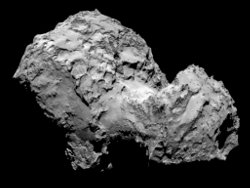Small Bodies

The Small Bodies group is composed of several research teams with interrelated interests and goals focused on the small and primitive bodies of the solar system. Its members span the disciplines of planetary sciences, with areas of expertise ranging from observational planetary astronomy, planetary geology, data analysis and interpretation, theoretical modeling, and mission leadership and support.
- What are the physical properties of small bodies in the Solar System (comets, asteroids, Kuiper Belt Objects, Centaurs, rings, and satellites) and how are they interrelated?
- What role did small bodies played in the evolution of the planets, with particular emphasis on the transport of volatiles and organic material into the inner Solar System?
- What is the Near Earth Object population, how can we catalogue them with specific emphasis on potentially hazardous objects?
Small Bodies: Missions and Projects
- Mars Science Laboratory Curiosity Rover
- WISE and NEOWISE
- Europa
- Cassini
- Mars Reconnaissance Orbiter
- Rosetta
Over the past decade the research areas led by the group include modeling the morphology of cometary jets; detection of volatile transport on Triton and Pluto; physical characterization of asteroids and cometary nuclei; physical characterization of extinct comets, asteroids, Kuiper Belt Objects, and Centaurs; formation and composition of the low-albedo side of Iapetus; the dynamics and physical properties of planetary rings; the search for Near-Earth Objects, including Potentially hazardous Objects, and the nature of Martian surface material. One of the world's leading planetary radar science teams is contained in the group. The group also provides scientific leadership for flight projects and for NASA. Members are also actively involved in outreach and education.